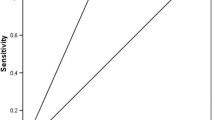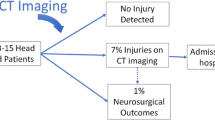Abstract
Traumatic brain injury (TBI) is one of the leading causes of death and disability in children, and progressive hemorrhagic injury (PHI) post TBI is associated with poor outcomes. Therefore, the objective of this study was to develop and validate a prognostic model that uses the information available at admission to determine the likelihood of PHI occurrence after TBI in children. The identified demographic data, cause of injury, clinical predictors on admission, computed tomography scan characteristics, and routine laboratory parameters were collected and used to develop a PHI prognostic model with logistic regression analysis, and the prediction model was validated in 68 children. Eight independent prognostic factors were identified: lower Glasgow coma scale score (3 ~ 8) (6 points), intra-axial bleeding/brain contusion (4 points), midline shift ≥5 mm (9 points), platelets <100 × 109/L (11 points), prothrombin time >14 s (6 points), international normalized ratio >1.25 (7 points), D-dimer ≥5 mg/L (14 points), and glucose ≧10 mmol/L (11 points). We calculated risk scores for each child and defined three risk groups: low risk (0–16 points), intermediate risk (17–36 points), and high risk (37–68 points). In the development cohort, the PHI rates after TBI for the low-, intermediate-, and high-risk groups were 10.1, 47.9, and 84.2%, respectively. In the validation cohort, the corresponding PHI rates were 10.9, 47.5, and 85.4%, respectively. The C-statistic for the point system was 0.873 (p = 0.586 by the Hosmer-Lemeshow test) in the development cohort and 0.877 (p = 0.524 by the Hosmer-Lemeshow test) in the validation cohort.
Conclusion: Using admission predictors, we developed a relatively simple risk score that accurately predicted the risk of PHI after TBI in children.
What is Known: • TBI is one of the leading causes of death and disability in children, and PHI post TBI is associated with poor outcomes. •Prediction of patients at low risk of PHI could help reduce treatment costs, whereas identification of patients at high risk of PHI could direct early medical intervention to improve outcomes. |
What is New: • This study firstly developed a risk score system by assessing the admission information that could provide an earlier prediction of the occurrence of PHI after acute TBI in children. |
Similar content being viewed by others
Abbreviations
- aPTT:
-
Activated partial thromboplastin time
- Fg:
-
Fibrinogen
- GCS:
-
Glasgow Coma Scale
- GOS:
-
Glasgow Outcome Scale
- INR:
-
International normalized ratio
- PHI:
-
Progressive hemorrhagic injury
- PT:
-
Prothrombin time
- TBI:
-
Traumatic brain injury
References
Alali AS, Fowler RA, Mainprize TG, Scales DC, Kiss A, de Mestral C, Ray JG, Nathens AB (2013) Intracranial pressure monitoring in severe traumatic brain injury: results from the American College of Surgeons Trauma Quality Improvement Program. J Neurotrauma 30(20):1737–1746
Allard CB, Scarpelini S, Rhind SG, Baker AJ, Shek PN, Tien H, Fernando M, Tremblay L, Morrison LJ, Pinto R (2009) Abnormal coagulation tests are associated with progression of traumatic intracranial hemorrhage. J Trauma Acute Care Surg 67(5):959–967
Chang EF, Meeker M, Holland MC (2006) Acute traumatic intraparenchymal hemorrhage: risk factors for progression in the early post-injury period. Neurosurgery 58(4):647–656
Control CfD, Prevention, (2005) Web-based injury statistics query and reporting system (WISQARS). National Center for Injury Prevention and Control, Centers for Disease Control and Prevention Online: www cdc gov/injury/wisqars/index html
Engström M, Romner B, Schalén W, Reinstrup P (2005) Thrombocytopenia predicts progressive hemorrhage after head trauma. J Neurotrauma 22(2):291–296
Epstein DS, Mitra B, O’Reilly G, Rosenfeld JV, Cameron PA (2014) Acute traumatic coagulopathy in the setting of isolated traumatic brain injury: a systematic review and meta-analysis. Injury 45(5):819–824
Farahvar A, Gerber LM, Chiu Y-L, Carney N, Härtl R, Ghajar J (2012) Increased mortality in patients with severe traumatic brain injury treated without intracranial pressure monitoring: clinical article. J Neurosurg 117(4):729–734
Fife D, Jagger J (1984) The contribution of brain injury to the overall injury severity of brain-injured patients. J Neurosurg 60(4):697–699
Folkerson LE, Sloan D, Cotton BA, Holcomb JB, Tomasek JS, Wade CE (2015) Predicting progressive hemorrhagic injury from isolated traumatic brain injury and coagulation. Surgery 158(3):655–661
Joseph B, Aziz H, Zangbar B, Kulvatunyou N, Pandit V, O’Keeffe T, Tang A, Wynne J, Friese RS, Rhee P (2014) Acquired coagulopathy of traumatic brain injury defined by routine laboratory tests: which laboratory values matter? J Trauma Acute Care Surg 76(1):121–125
Joseph B, Aziz H, Pandit V, Hays D, Kulvatunyou N, Tang A, Wynne J, Keeffe TO, Green DJ, Friese RS (2014) Prothrombin complex concentrate use in coagulopathy of lethal brain injuries increases organ donation. Am Surg 80(4):335–338
Juratli TA, Zang B, Litz RJ, Sitoci K-H, Aschenbrenner U, Gottschlich B, Daubner D, Schackert G, Sobottka SB (2014) Early hemorrhagic progression of traumatic brain contusions: frequency, correlation with coagulation disorders, and patient outcome: a prospective study. J Neurotrauma 31(17):1521–1527
Kraus JF, Fife D, Cox P, Ramstein K, Conroy C (1986) Incidence, severity, and external causes of pediatric brain injury. Am J Dis Child 140(7):687–693
Kurland D, Hong C, Aarabi B, Gerzanich V, Simard JM (2012) Hemorrhagic progression of a contusion after traumatic brain injury: a review. J Neurotrauma 29(1):19–31
Mayer T, Walker ML, Johnson DG, Matlak ME (1981) Causes of morbidity and mortality in severe pediatric trauma. JAMA 245(7):719–721
Melhem S, Shutter L, Kaynar AM (2014) A trial of intracranial pressure monitoring in traumatic brain injury. Crit Care 18(1):302
Oertel M, Kelly DF, McArthur D, Boscardin WJ, Glenn TC, Lee JH, Gravori T, Obukhov D, McBride DQ, Martin NA (2002) Progressive hemorrhage after head trauma: predictors and consequences of the evolving injury. J Neurosurg 96(1):109–116
Sanus GZ, Tanriverdi T, Alver I, Aydin S, Uzan M (2004) Evolving traumatic brain lesions: predictors and results of ninety-eight head-injured patients. Neurosurg Q 14(2):97–104
Schnüriger B, Inaba K, Abdelsayed GA, Lustenberger T, Eberle BM, Barmparas G, Talving P, Demetriades D (2010) The impact of platelets on the progression of traumatic intracranial hemorrhage. J Trauma Acute Care Surg 68(4):881–885
Seifman MA, Lewis PM, Rosenfeld JV, Hwang PY (2011) Postoperative intracranial haemorrhage: a review. Neurosurg Rev 34(4):393–407
Stein SC, Spettell CM (1995) Delayed and progressive brain injury in children and adolescents with head trauma. Pediatr Neurosurg 23(6):299–304
Stein SC, Young GS, Talucci RC, Greenbaum BH, Ross SE (1992) Delayed brain injury after head trauma: significance of coagulopathy. Neurosurgery 30(2):160–165
Thurman DJ (2016) The epidemiology of traumatic brain injury in children and youths: a review of research since 1990. J Child Neurol 31(1):20–27
Tian H-L, Chen H, Wu B-S, Cao H-L, Xu T, Hu J, Wang G, Gao W-W, Lin Z-K, Chen S-W (2010) D-dimer as a predictor of progressive hemorrhagic injury in patients with traumatic brain injury: analysis of 194 cases. Neurosurg Rev 33(3):359–366
Vedantam A, Yamal J-M, Robertson CS, Gopinath SP (2015) 119 Progressive hemorrhagic injury after severe traumatic brain injury: effect of hemoglobin transfusion thresholds. Neurosurgery 62:203
W-s T, Zheng P, Xu J-f, Guo Y-j, J-s Z, Yang W-j, G-y L, He B, Yu H (2011) Early CT signs of progressive hemorrhagic injury following acute traumatic brain injury. Neuroradiology 53(5):305–309
Yeates KO, Swift E, Taylor HG, Wade SL, Drotar D, Stancin T, Minich N (2004) Short- and long-term social outcomes following pediatric traumatic brain injury. J Int Neuropsychol Soc 10(03):412–426
Yuan Q, Wu X, Du Z-Y, Sun Y-R, Yu J, Li Z-Q, Wu X-H, Mao Y, Zhou L-F, Hu J (2015) Low-dose recombinant factor VIIa for reversing coagulopathy in patients with isolated traumatic brain injury. J Crit Care 30(1):116–120
Acknowledgments
The study was funded by the financial support of Jiangxi Province’s Department of Education Project (GJJ14079) and Jiangxi Province’s Science and Technology Agency Support Program (No. 20161BBI90054).
Authors’ Contributions
All authors participated in study design, data collection, and manuscript drafting and approving.
Data analyses were performed by Guo-wen Hu and Hai-li Lang.
Author information
Authors and Affiliations
Corresponding author
Ethics declarations
The study was approved by the committee for human studies of The Second Affiliated Hospital of Nanchang University, and a parent had to give an informed consent prior to recruitment in the study.
Conflict of interest
The authors declare that they have no conflict of interest.
Additional information
Communicated by Patrick Van Reempts
Revisions received: 28 Jan 2017 / 17 Mar 2017
Rights and permissions
About this article
Cite this article
Hu, Gw., Lang, Hl., Guo, H. et al. A risk score based on admission characteristics to predict progressive hemorrhagic injury from traumatic brain injury in children. Eur J Pediatr 176, 689–696 (2017). https://doi.org/10.1007/s00431-017-2897-9
Received:
Revised:
Accepted:
Published:
Issue Date:
DOI: https://doi.org/10.1007/s00431-017-2897-9




